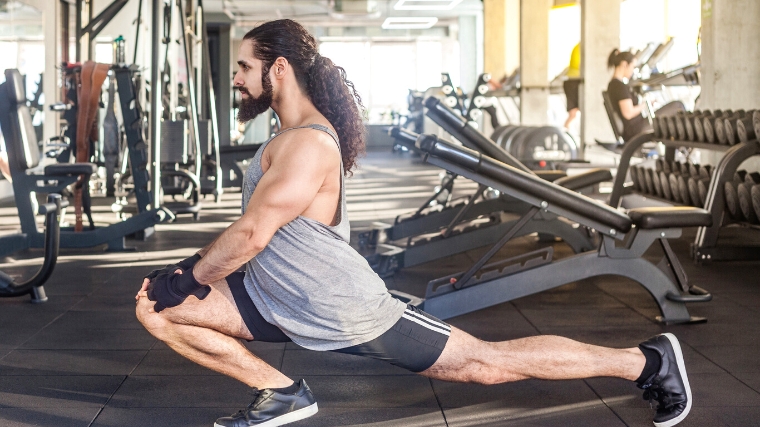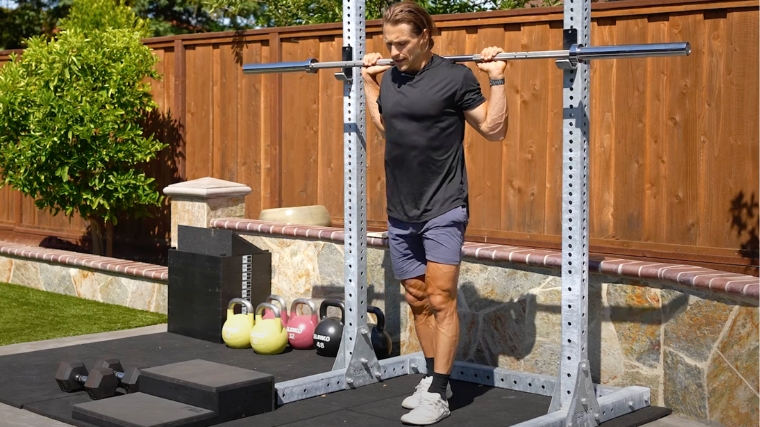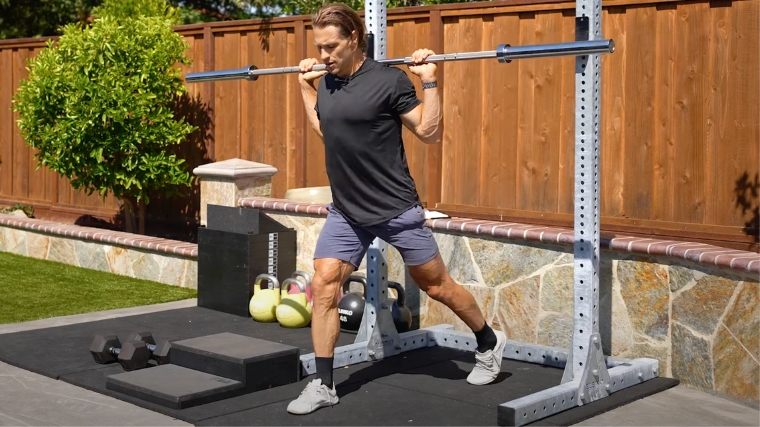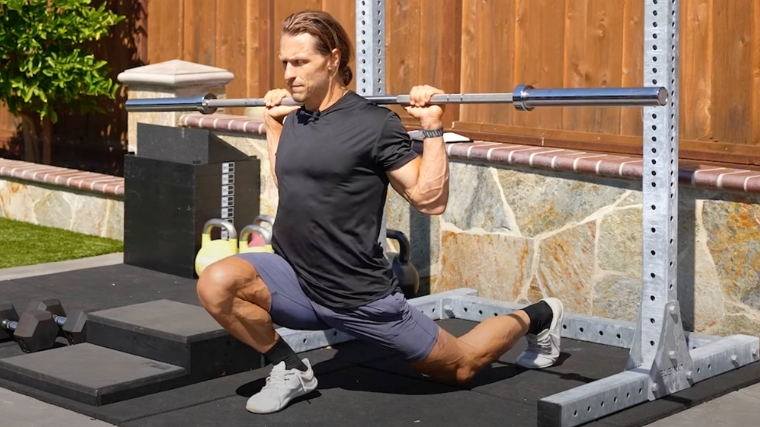In the land of leg gains, depth is king. No matter what exercises you perform or what your goals are, by and large, utilizing a full range of motion will move the needle better than cutting things short.
This is as true for the standard back squat as it is for your accessories of choice. If you want to chew up every last morsel of potential muscle gain, you need a single-leg exercise that ups the ante on your range of motion. You need to do the ATG (that’s “ass-to-grass”) split squat.

As the name implies, this modified single-leg squat is all about emphasizing your range of motion. In doing so, you kill two birds with one stone: Bigger, stronger legs and robust mobility through your hips, knees, and ankles. Here’s how to properly execute the ATG split squat.
- How to Do the ATG Split Squat
- ATG Split Squat Sets and Reps
- Common ATG Split Squat Mistakes
- ATG Split Squat Variations
- ATG Split Squat Alternatives
- Muscles Worked by the ATG Split Squat
- Benefits of the ATG Split Squat
- Who Should Do the ATG Split Squat
- Frequently Asked Questions
How to Do the ATG Split Squat
Other than decently-mobile joints, there’s no mandatory equipment for the ATG split squat. However, to get the best bang for your buck, you should probably work with some weight on this one.
This guide will teach you how to do an ass-to-grass split squat with a barbell. Read on for more information on how to load this movement in alternate ways.
Step 1 — Unrack Your Bar

Remove a lightly-loaded barbell from a squat or power rack as if you were going to perform a standard back squat. The bar should rest on the meat of your upper traps. Grip the bar firmly enough that it stays in place.
Coach’s Tip: Grabbing the bar with a wide grip may help you maintain your balance.
Step 2 — Split Your Feet

Step forward with your dominant leg and plant your foot roughly two feet in front of you. The heel of your back foot should come off the ground such that you’re balancing on your toes. Put a majority of your weight onto your front leg.
Coach’s Tip: To improve your balance, you can step forward and slightly out to the side.
Step 3 — Sink Forward

This is where the ATG split squat diverges from a standard single-leg squat. Initiate the movement by dropping your hips down and forward, as if you were pushing all your weight into your front leg.
The knee of your working leg should travel forward over your toes and the back of your thigh should come into contact with your calf. Push as far as you can without your front heel coming off the floor, and then reverse the motion by straightening your working leg.
Coach’s Tip: Think about driving your front heel into the ground the entire time to really stretch out your ankles.
ATG Split Squat Sets and Reps`
An extra-deep split squat is both a muscle-building machine and a great way to stretch and mobilize your lower body. Here are a few different ways you can program the ATG split squat:
- For Muscle Growth: Go for 3 sets of 6 to 8 reps with a slow tempo and moderate weight.
- For Leg Strength: Try 2 or 3 sets of 5 reps with a heavy weight.
- To Improve Flexibility: Use a light weight and do 2 sets of 10 or more reps with a controlled tempo.
Common ATG Split Squat Mistakes
You don’t want to miss the mark on the ATG split squat. It’s a remarkably potent accessory exercise for your lower body if you can get the technique right. Keep these mistakes in mind so you can sidestep them when you start your set.
Cutting Your Range of Motion
An excessive range of motion is the hallmark feature of a good ATG split squat. If you aren’t pushing far into your working leg, you’re leaving gains on the table and may even be wasting your time altogether.
You may have to modify your setup in some way to ensure you can access a deep squat (such as putting a wedge under your heel to improve your ankle mobility), but in any case, you need to make your hamstrings touch your calves on every rep.
Too Much Weight on the Back Leg
Improperly distributing your own body weight can cause things to go awry during any single-leg movement. When you perform the ATG split squat, putting too much weight on your back leg will likely alter your posture and possibly prevent you from getting your working leg into a deep enough range of motion.
Restricted Knee Travel
It isn’t a strict requirement necessarily, but getting your working knee past your toes is a defining feature of the ATG split squat. Doing so requires solid ankle mobility. If you have it already, the ATG split squat probably feels quite natural to you.
If you don’t, you can use the movement to unlock your ankles. When you perform the ATG split squat, be patient on every rep and strive to inch your knee forward just a tiny bit more each time.

Despite what you may have heard, there’s nothing intrinsically wrong or dangerous about forward knee travel, provided you have the mobility for it. If you’re forcing your knee forward hard enough that your heel flutters off the floor, you may be doing more harm than good by compensating for a level of mobility that your ankle doesn’t yet possess.
Pushing your knee over your toe will increase muscle activation in the quadriceps and stimulate the connective tissue that binds your ankle. (1) It’s in no way injurious or dangerous, as long as you aren’t nursing an injury or trying to work with a load you aren’t ready for.
ATG Split Squat Variations
If you want to put a spin on the ass-to-grass split squat, try out one of these variations. The movement may not be as modifiable as some other exercises out there, but you can still adjust it to better suit your training needs.
Front-Foot-Elevated ATG Split Squat
Elevating your front foot on the ATG split squat will shift the focus away from knee travel and more towards hip flexion. As a result, this variation should stimulate your glutes a bit more than your quads.
You can also place your front foot onto a block or weight plate if you want to prioritize hip mobility. Elevating your front foot may limit the amount of forward knee travel, but you should be able to sink deeper into hip flexion.
Dumbbell ATG Split Squat
Working with the barbell is ideal in a lot of circumstances, but it may not be appropriate for you during the ATG split squat. If you opt to work with dumbbells, the exercise should become less of a balancing act.
The barbell is great for maximizing your loading potential, but you have to physically grip it with your hands. This can negatively affect your balance. Holding a pair of dumbbells at your sides should provide more stability and allow you to correct any bodily swaying or tipping. If you need to exit the set immediately due to muscular failure, dumbbells are also easier to “ditch.”
ATG Split Squat Alternatives
For most gymgoers, there’s no such thing as a true must-do movement. In some cases, the ATG split squat can be more trouble than it’s worth. If you want to reap many of the benefits the exercise provides but can’t seem to make it work, try out these alternatives to the ATG split squat instead.
Bulgarian Split Squat
If you want to maximize muscular strength and size and aren’t overly concerned with your lower-body mobility, you can do Bulgarian split squats instead of ATG split squats.
Bulgarians are also known as rear-foot-elevated split squats. Placing your back leg onto a bench or box instead of the floor lets you squat deeply, but will limit your ability to push your knee beyond your toes in some cases. However, you can use heavier weights most of the time.
Step-Up
You can get vertical with your leg training by performing step-ups instead. Whether you opt to work with weights or not, step ups are both a leg-builder and an awesome conditioning exercise.
The higher the surface you’re stepping to, the more hip flexibility you’ll need to perform the movement properly. This makes the step-up extremely customizable in accordance with your training needs.
Split Snatch
Decades ago, Olympic lifters used the ATG split squat to catch heavy weights overhead in movements like the split snatch or split clean. The posture allows you to get very low to the floor, giving you the most room to hold a loaded barbell over your head.
Though the split snatch may have fallen out of fashion among weightlifters, you can give it a try for yourself. It’s an extremely intricate movement that you should probably learn from an in-person coach, but is also a lot of fun and can be great for teaching bodily coordination and developing explosive power.
Muscles Worked by the ATG Split Squat
Whether you’re squatting, pulling, pressing, or performing five sets of ATG split squats on leg day (a true challenge), you need a working knowledge of your own anatomy. Understanding how a given exercise works certain muscles can impact your motivation and help you make better gains.
Quads
Any movement that involves bending or extending your knee will activate your quadriceps to some degree. Your quads are a four-compartment muscle on the front of your thigh that, principally and almost exclusively, work to straighten your knee against resistance.
Unrestricted ankles will allow you to push your knee forward during the ATG split squat. This places more load on your quads the further you go. Good flexibility — which the movement both requires and creates — is thus integral to building your quads with the ATG split squat.
Glutes
Hip flexion, or the angle of your thigh relative to your torso, activates your glutes. Your gluteal muscles (the gluteus maximus, medius, and minimus) cross the hip joint and primarily perform hip extension.
An exercise like the ATG split squat is fantastic for glute development specifically because it allows you to sit into a deep squat position with a lot of hip flexion. The bottom of the squat is where your glutes are placed under the greatest amount of stretch, and are thus primed for growth.
Core
All lower-body exercises are, in part, core exercises (that is, if you’re working with free weights) as well. Your core is composed of more than just your abdominal muscles: Your obliques, which resist side-to-side twisting, and your lower back also contribute to core stability.

[Read More: The Best Bodyweight Exercises, + Workouts and Tips From a CPT]
Splitting your feet during the ATG split squat is the challenging part for your core. By altering your base of support and placing your feet far away from your center of gravity, your core has to work overtime to stabilize your torso while you perform your reps.
Benefits of the ATG Split Squat
Is the ATG split squat right for you? To answer that question, you need to know the specific benefits the exercise provides. Here’s a shortlist of what to expect if you incorporate it into your next leg workout:
Great for Hip Mobility
The ATG split squat is among the best movements you can do to increase your lower-body flexibility. Placing your knees and hips under load and taking them into the deepest ranges of motion is fantastic for building long-lasting mobility in those joints.
[RELATED: Best Mobility Exercises]
Builds Your Quads and Glutes
When it comes to building muscle, any exercise you perform should meet a few criteria. It should be safely loadable, take the muscles in question through a large range of motion, and be practical to perform with the equipment you have access to.
The ATG split squat checks all those boxes, making it a stellar pick for leg hypertrophy or as an accessory movement to your back squat training if you’re a powerlifter.
Improves Ankle Mobility
Training for strength or muscularity isn’t entirely distinct from improving your mobility. If you lift through a full range of motion with added resistance, you’re essentially performing a loaded stretch.
This is more true for some exercises, like the ATG split squat, than others. You’ll most often perform this exercise with a slow cadence and great attention paid to your technique. As a result, you should expect to improve your ankle mobility as you gradually drive your knee further forward over your toe.
Who Should Do the ATG Split Squat
Whether you’re trying to get limber, are practicing for a strength sport, or want to grow muscle with a new movement, the ATG split squat is for you. Here’s how this exercise helps you work toward those specific goals.
If You’re Inflexible
The ATG split squat is a fantastic option as a loaded stretch or warm-up drill for flexibility. It requires you to push your hip, knee, and ankle joints to the ends of their ranges of motion against resistance. That’s the ideal recipe for improving your mobility.
Weightlifters
Weightlifters may perform only the snatch and clean & jerk in competition, but your accessory training should be diverse and cover a wide array of athletic qualities. Moreover, Olympic lifting is almost exclusively bilateral — you spend a vast majority of your time working with your legs firmly under your body.
Including a movement like the ATG split squat as part of your accessory training can introduce some much-needed variety to the stimulation you give your body and help keep your hips mobile at the same time.
Bodybuilders
Building muscle is all about finding the right movement for the muscles in question. If lunges or Bulgarian split squats aren’t doing it for you, you might want to try the ATG split squat instead.

[Read More: The Best Quad Exercises and Quad Workouts for Muscle Gain]
To maximize your results from this exercise, though, you need solid ankle and hip mobility. Without them, you can’t access the ranges of motion that stretch your muscles the most. This is a cost-benefit analysis you’ll have to do yourself.
Making Strides
A good leg exercise does more than one thing at a time. The ATG split squat builds your quads and glutes, sure. But it also helps you get more flexible. Oh, and it improves your balance. You can also do it just about anywhere, with any type of equipment (or none at all).
The ATG split squat boasts a long list of potential benefits, while the drawbacks are slight and few. You have little to lose and so, so much to gain. Get your ass to the grass and see for yourself.
FAQs
Still scratching your head about the ATG split squat? No worries. Here are a few common questions about the exercise, answered.
What does “ATG” stand for?
“ATG” means ass-to-grass. In weight lifting, it is a general descriptor that refers to squatting as deep as functionally possible on an exercise. Note that it doesn’t literally mean you can touch the floor with your buttocks. That said, for a squat to count as “ATG” your hip crease should be well below your kneecap in the bottom.
Are ATG split squats bad for my knees?
Not necessarily. If you’re healthy and not dealing with an injury, no exercise is directly injurious on its own. That said, ATG split squats do take several joints into extreme ranges of motion and usually against external load.
If you’re not used to working in these ranges, this may apply more stress to your body than it can bear. Your best bet is to take things slow in the beginning and perform ATG split squats without any weight before loading up.
References
- Schoenfeld B. J. (2010). Squatting kinematics and kinetics and their application to exercise performance. Journal of strength and conditioning research, 24(12), 3497–3506.
Featured Image: Khosro / Shutterstock